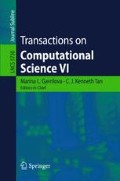Abstract
In order to identify a model that best predicts spatial patterns it is necessary to first explore the spatial properties of the data that will be included in a predictive model. Exploratory analyses help determine whether or not important statistical assumptions are met, and potentially lead to the definition of spatial patterns that might exist in the data. Here, we present results from exploratory analyses based on data describing illegal oil spills detected by the National Aerial Surveillance Program (NASP) in Canada’s Pacific Region, and marine vessel traffic, the possible source of these oil discharges. We identify and describe spatial properties of the oil spills, surveillance flights and marine traffic, to ultimately identify the most suitable predictive model to map areas where these events are more likely to occur.
Access this chapter
Tax calculation will be finalised at checkout
Purchases are for personal use only
Preview
Unable to display preview. Download preview PDF.
References
International Marine Organization: International Convention from the Prevention of Pollution from Ships, 1973, as modified by the Protocol of 1978 relating thereto (MARPOL 73/78), http://www.imo.org/Conventions/contents.asp?doc_id=678&topic_id=258
National Research Council: Oil in the sea III: Inputs, Fates, and Effects. National Academies Press, Washington (2003)
Armstrong, L., Derouin, K.: National Aerial Surveillance Program 2001-2004. Final report. Transport Canada Marine Safety, Ottawa, Canada (2004)
McGregor, M., Gautier, M.-F.: Enhancing Situational Awareness in the Arctic Through Aerial Reconnaissance. In: Environment Canada, Marine & Ice Services, Ottawa, Ontario, Canada (2008)
Serra-Sogas, N., O’Hara, P., Canessa, R., Keller, P., Pelot, R.: Visualization of spatial patterns and temporal trends for aerial surveillance of illegal oil discharges in western Canadian marine waters. Marine Pollution Bulletin 56, 825–833 (2008)
Anselin, L.: Spatial Econometrics: Methods and Models. Martinus Nijhoff, Dordrecht (1988)
Goodchild, M.F.: Spatial Autocorrelation. In: Concepts and Techniques in Modern Geography, vol. 47. Geo Books, Norwich (1985)
Bailey, T., Gatrell, A.: Interactive Spatial Data Analysis. Longman Scientific & Technical. Burnt Mill, Essex (1995)
Griffith, D.A.: What is spatial autocorrelation? Reflections on the past 25 years of spatial statistics. L’Espace geographique 3 (1992)
Haggett, P., Cliff, A.D., Frey, A.: Locational Analysis in Human Geography 2. Edward Arnold, Great Britain (1977)
Tobler, W.: A computer movie simulating urban growth in the Detroit region. Economic Geography 46, 234–240 (1970)
Boots, B.: Local measures of spatial association. Ecoscience 9(2), 168–176 (2002)
Fotheringham, A.S., Brunsdon, C., Charlton, M.: Geographically Weighted Regression: the analysis of spatially varying relationships. John Wiley & Sons, Ltd, England (2002)
O’Hara, P., Morgan, K.: Do low rates of oiled carcass recovery in beached bird surveys indicate low rates of ship-source oil spills? Marine Ornithology 34, 133–140 (2006)
British Columbia’s Coastal Environment: Alive and Inseparable. BC Government Publications (2006)
O’Sullivan, D., Urwin, D.J.: Geographic Information Analysis. John Wiley & Sonds, New Jersey (2003)
Sawada, M.: Rookcase: an Excel 97/ Visual Basic (VB) add-in for exploring global and local spatial autocorrelation. Bulletin of the Ecological Society of America 80, 231–234 (1999/2000)
Anselin, L.: Exploring Spatial Data with GeoDa: A Workbook. Spatial Analysis Laboratory, University of Illinois, IL (2005)
Anselin, L.: Local indicators of spatial autocorrelation—LISA. Geographical Analysis 27, 93–115 (1995)
Anselin, L., Syabri, I., Kho, Y.: GeoDa: An introduction to Spatial Data Analysis. In: Spatial Analysis Laboratory, Department of Agricultural and Consumer Economics, University of Illonois, IL (2005)
Haining, R.: Spatial data analysis in the social and environment science. Cambridge University Press, Cambridge (1990)
Paéz, A., Uchida, T., Miyamoto, K.: A general framework for estimation and inference of geographically weighted regression models: 1. Location-specific kernel bandwidths and a test for locational heterogeneity. Environmental and Planning A 34, 733–754 (2002)
Zhang, L., Gove, J.H., Heath, L.S.: Spatial residual analysis of six modeling techniques. Ecological Modelling 186, 154–177 (2005)
Jelinski, D.E., Wu, J.: The modifiable areal unit problem and implications for landscape ecology. Landscape Ecology 11(3), 129–140 (1996)
O’Hara, P.D., Serra, N., Canessa, R., Keller, P., Pelot, P.: Estimating oil spill rates and deterrence based on aerial surveillance data in Western Canadian marine waters. Marine Pollution Bulletin (submitted, 2008)
Author information
Authors and Affiliations
Editor information
Editors and Affiliations
Rights and permissions
Copyright information
© 2009 Springer-Verlag Berlin Heidelberg
About this chapter
Cite this chapter
Serra-Sogas, N., O’Hara, P., Canessa, R., Bertazzon, S., Gavrilova, M. (2009). Exploratory Spatial Analysis of Illegal Oil Discharges Detected off Canada’s Pacific Coast. In: Gavrilova, M.L., Tan, C.J.K. (eds) Transactions on Computational Science VI. Lecture Notes in Computer Science, vol 5730. Springer, Berlin, Heidelberg. https://doi.org/10.1007/978-3-642-10649-1_13
Download citation
DOI: https://doi.org/10.1007/978-3-642-10649-1_13
Publisher Name: Springer, Berlin, Heidelberg
Print ISBN: 978-3-642-10648-4
Online ISBN: 978-3-642-10649-1
eBook Packages: Computer ScienceComputer Science (R0)

